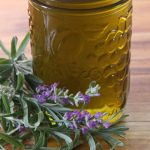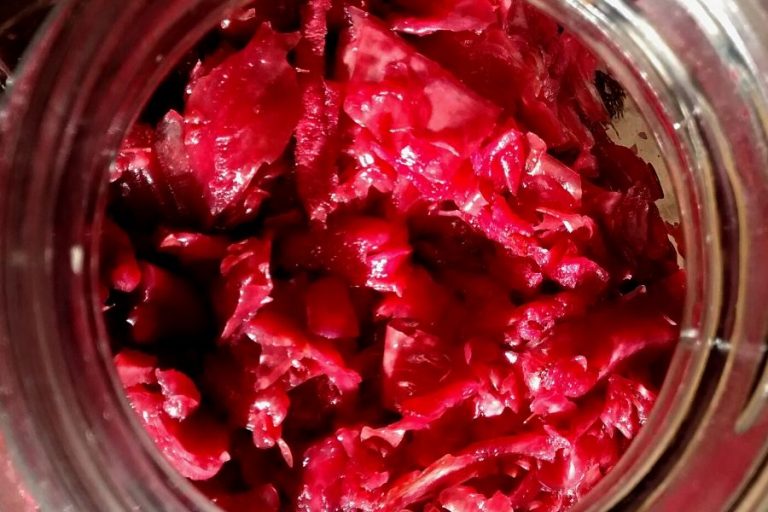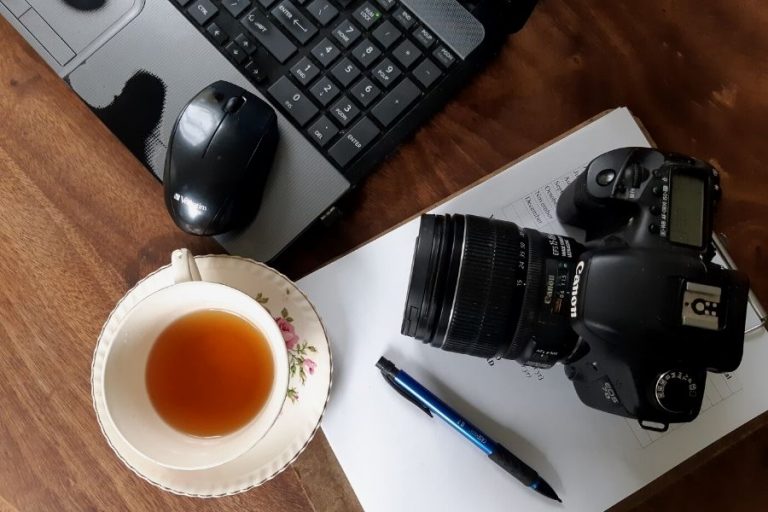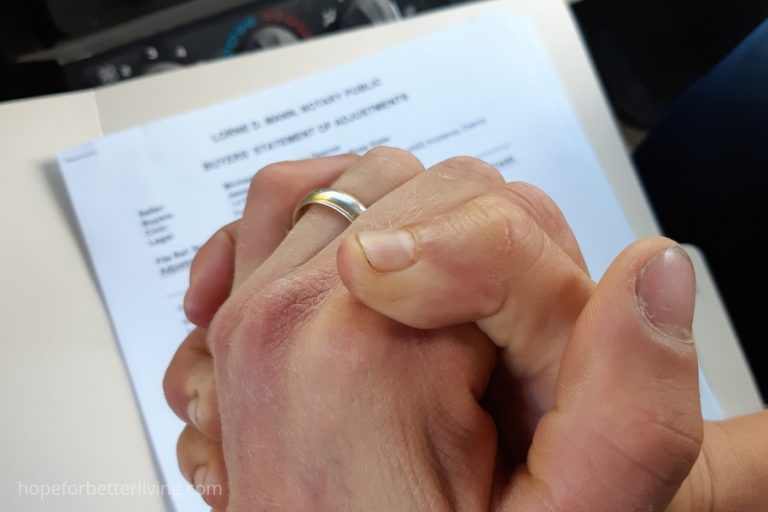How to Make Lavender Infused Oil with Fresh Lavender
Learn how to make lavender infused oil for your homemade skincare products, using fresh lavender from the garden!
If you create your own body care products and have access to fresh lavender, you'll enjoy making this lavender infused oil.
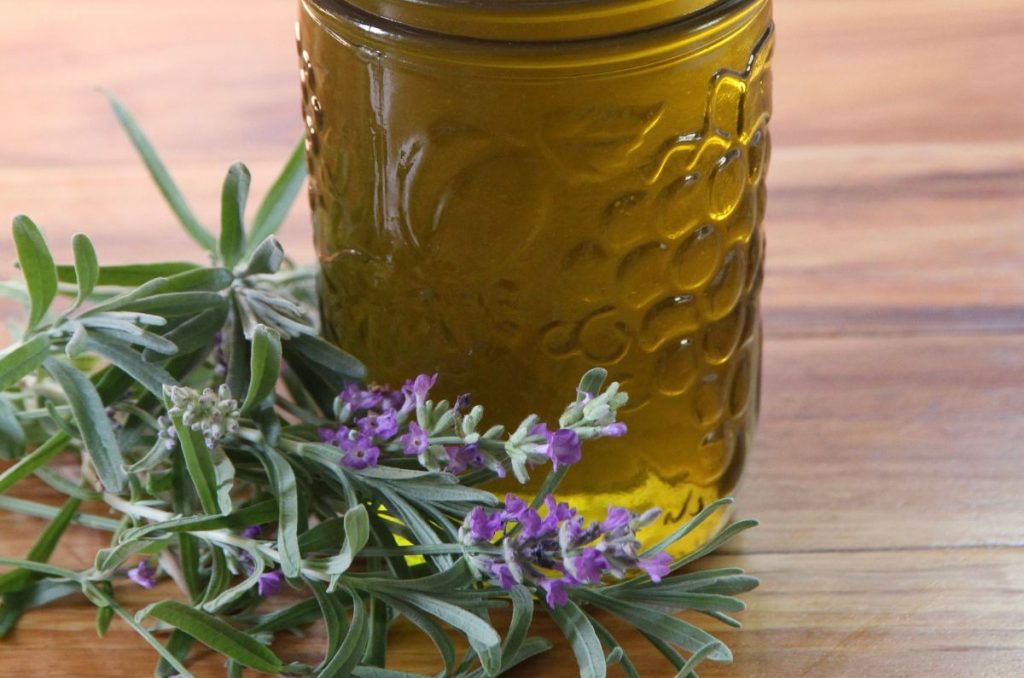
Learning to make your own infused oil is a resourceful way to add the beneficial properties of lavender and other herbs to your homemade skincare products.
I first started making my own herb-infused oils after I was newly married. At the time, I was working to build a small, skincare business. While trying to find ways to lower costs of my craft, I discovered and learned to infuse herbs in oil, so I could skip (or use less of) the expensive essential oils.
At the time, I didn't have a real garden, so I foraged plants and bought dry herbs in bulk for my homemade infusions.
Making my own herb oil was fun, and I could make a lot in one batch. Being able to skip the cost of essential oils was nice. And I liked the hands on aspect of the start-to-finish process.
Nearly a decade later, I'm fortunate to live in a location where I can have perennial garden and specifically grow herbs that are good for the skin. One of them is lavender.
Yes, I get to make my own lavender oil now!
While I understand it's easier to add a dozen drops of lavender essential oil to homemade skincare products, I also understand I enjoy the process more when I have the start-to-finish aspect.
Call me old fashioned, but there's something very satisfying about growing my own lavender, harvesting it, infusing it in oil and then using it to create nourishing skincare products for my family and I.
So while pure essential oils have their place in my home, I find great enjoyment in using this old school method...and I get to enjoy the sweet aroma of lavender throughout!
Best Types of Lavender to Use for Infusing
You can use just about any type of lavender for infused oil. The best types are often the most fragrant. Here's a few to start with!
- Dwarf Munstead
- English lavender
- Hidcote lavender
- Munstead lavender (I grow this one)
- Vera lavender
Note for my northern folks: if you're looking for a cold hardy lavender variety, Hidcote Lavender is supposed to be hardy down to -40, provided you give it some sort of straw or leaf mulch cover before winter arrives.
Can I Use Dry Lavender Instead of Fresh Lavender?
Yes, you can use dry lavender to make infused oil, whether you dehydrate it yourself or purchase it in bulk!
In fact, some folks prefer to use dried lavender flowers and leaves, so they can avoid all risk of mold. Dried plant matter doesn't introduce water content to the oil, but you'll lose some of the plant oils in the drying process.
Where to Find Dry Lavender
It's easy to find and buy organic dried lavender online.
Get quality, organic lavender grown in France here.
This brand is also good for culinary uses.
Lavender is becoming more popular, so you may even be able to find it locally. And if you grow your own, it's easy to dry lavender at home. Use a food dehydrator to dry flowers on their stems. You can dehydrate just lavender buds on their green stems, or use the leaves as well
Regardless of whether you use fresh or dried lavender, it's all the same when it comes to making infused oil. Stuff your jar with lavender and cover it with oil.
Follow the directions in this tutorial and you'll have lavender oil in a few week's time!
Where to Get Fresh Lavender
If you're keen on using fresh lavender flowers and leaves, I'd highly recommend growing your own! They aren't the easiest to start from seed, so you may want to get seedlings from a local garden center.
Gardeners refer to lavender as a short lived perennial (meaning it will return, but only for 4-5 years). But even still, half a dozen lavender plants will give you a good harvest.

Lavender can be planted in a vegetable garden, flowers beds or in a herb garden. And like many herbs, it prefers dryness and even poorer soils.
If you don't grow your own, you can probably find fresh lavender at summer farmers markets or local farms. The stems of fresh flowers are most often sold, so you may have to put in a custom order for actual plant cuttings!
Best Carrier Oils for Skincare Products
Choosing a skin-nourishing oil is almost as important for homemade body care products. I would recommend choosing from the list below.
Important note: most of the items linked below are only 16 oz bottles, so you'll need two for this recipe. Or, if you plan this halve the recipe anyway, these bottles will be about perfect.
There are two types of healthy oils you can choose from.
Heavy Oils
Heavy oils are usually very thick and sticky in texture. And while they're more moisturizing, the skin can't absorb it as quickly as lighter oils.
Three common options include:
- Castor oil (only use if adding small amounts to other oils!)
- Sweet almond oil
- Extra virgin olive oil
Light Oils
Light oils are less dense, and your skin will absorb them quite quickly!
Of course, you don't have to stick with 1 type of oil; you can mix types together as you prefer!
How to Make Lavender Infused Oil
Items You'll Need
- basket
- pruning shears
- clean glass jar (1 quart or litre)
- 32 oz (1 litre) carrier oil of your choice
- bowl
- cotton cloth for filtering (a fine mesh strainer may work too)
Step 1: Harvest Fresh Lavender from the Garden
Harvest fresh lavender just after the morning dew lifts from your garden, before the sun's heat can evaporate oils in the flower buds and leaves. I like to use a pair of pruning shears to harvest stems just a few inches above the base.
Pile fresh lavender into a basket as you go, until you have a bundle that fills one hand.
Step 2: Wash Your Glass Jar
Bring your lavender harvest inside and let it sit while you wash and dry a glass jar. Do make sure the jar is dry; you don't want any extra water present during the infusing process, or you may have issues with mold.
Step 3: Cut Your Lavender into Short Lengths
Use your pruning shears to cut lavender into 1-2 inch lengths. It doesn't matter if you have woody stems, or if some of the leaves are dry and brown at the base (so long as they aren't moldy).
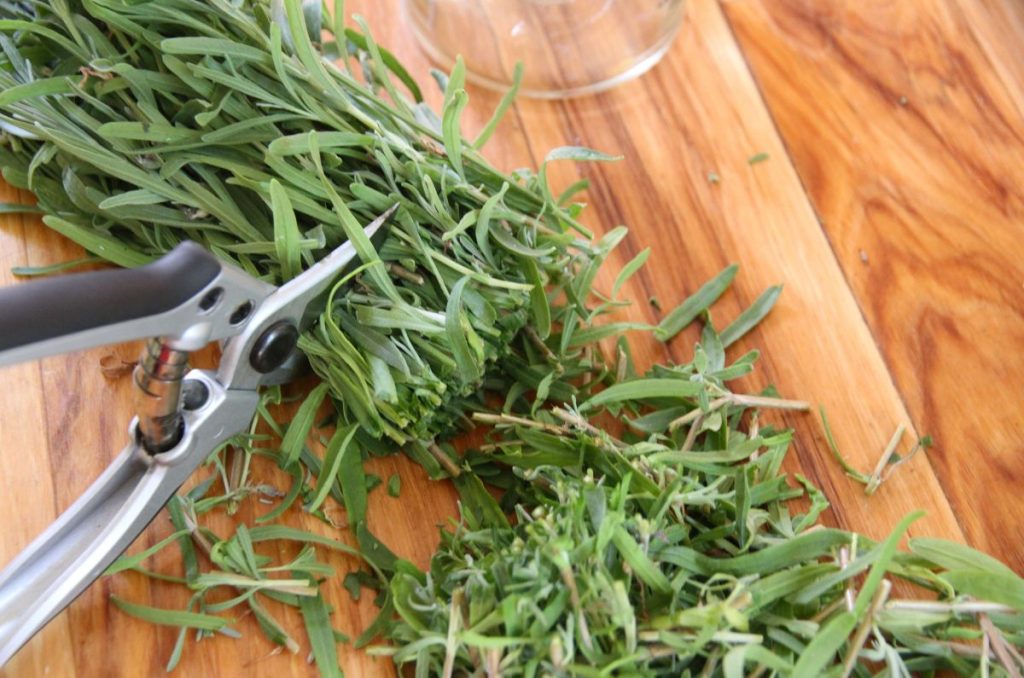
Chop everything up, so the lavender will release it's beneficial properties, faster.
Step 4: Stuff Chopped Lavender Into Glass Jar
There's nothing delicate about this process (unless it's the beautiful aroma that will be filling your senses at this point!).
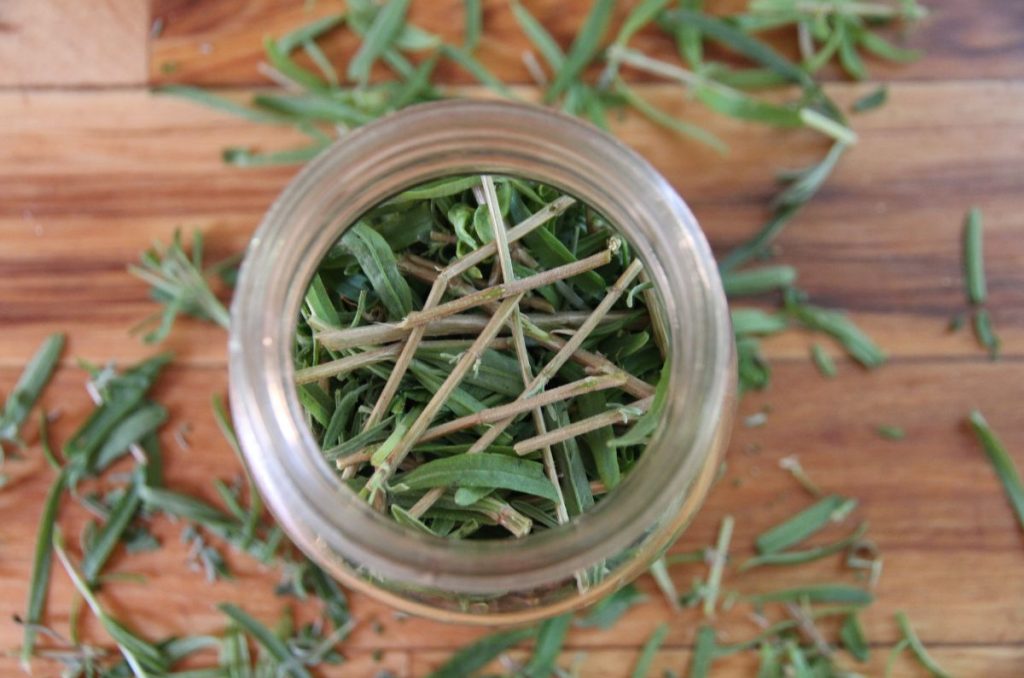
Stuff as much chopped lavender into the glass jar, until you can't add any more. Stop when you reach the threaded neck of the jar.
Step 5: Cover Fresh Lavender with Oil
Choose your carrier oil/s, and cover the fresh lavender with liquid oil. Add oil, until plant matter is covered with about 1//4 inch to spare.
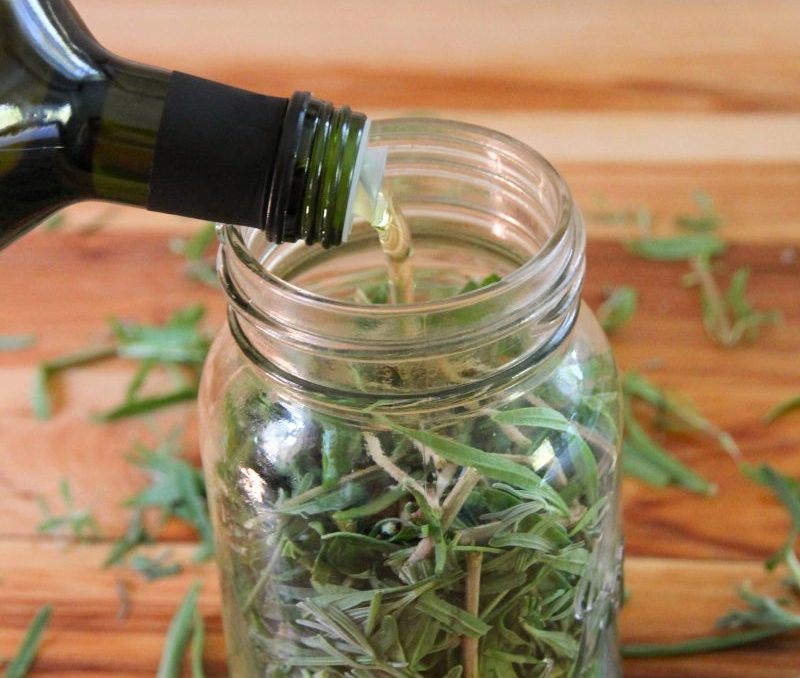
Step 6: Add Lid to Jar and Store in a Dark Place
Add a tight fitting lid, and store the glass mason jar in a dark place. I often place a folded paper towel or cloth under the jar, just in case something spills out while I'm handling it.
Some folks prefer to leave the jar in direct sunlight, so the sun warms the oil. Still others will heat the oil and plant matter in a double boiler to hurrying the extracting process along.
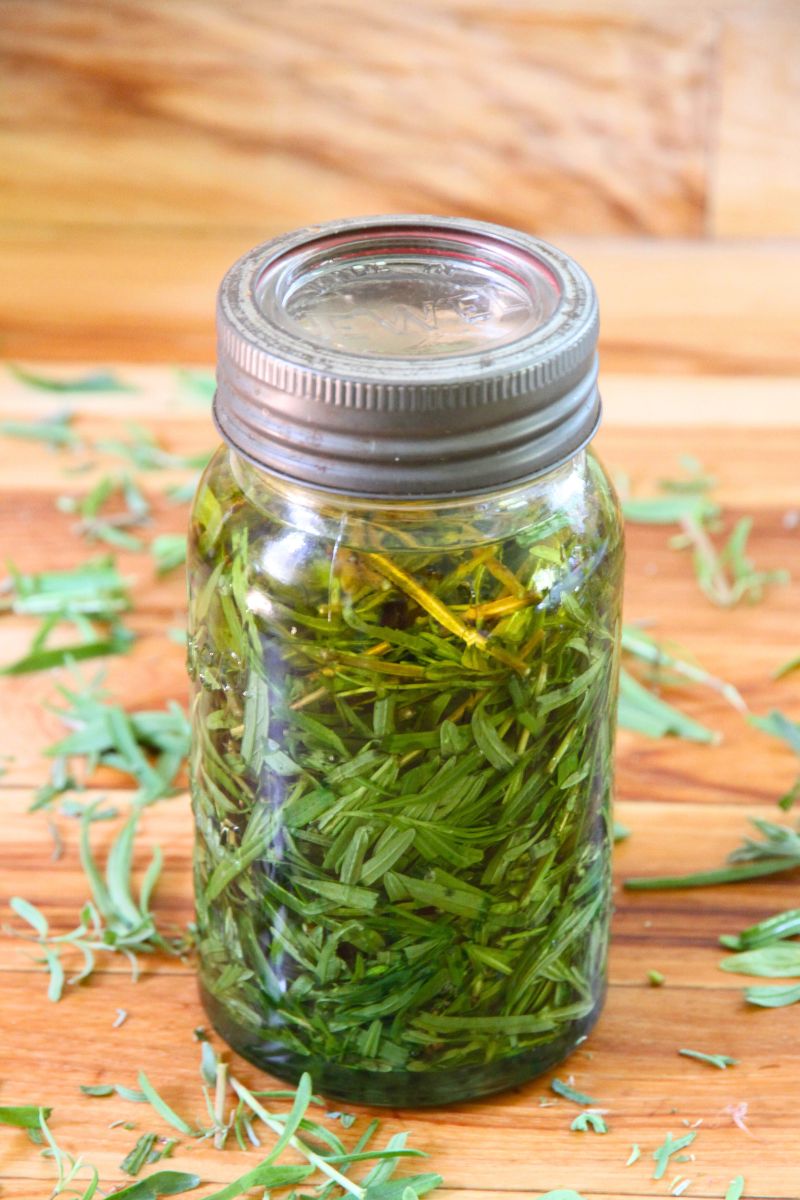
But I like to keep it simple, so my jar sits at room temperature, on a dark shelf in my pantry.
Step 6: Shake Jar Daily for 1-2 Weeks
You shouldn't have any issues with mold, but giving the jar a shake every day (or every other day) is a great way to make sure nothing goes wrong!

If you can remember, do this for the first week. After the first few days, you'll observe that leaves and flowers have lost their soft green tone.
This is a good sign! It means the oil is penetrating and the infusion is taking place.
Step 7: Strain Out Plant Material and Rejar
When you're happy with the aroma and strength of your oil, it's time to strain out your plant material. Here are step-by-step instructions for you to follow. Also see the printable directions below!
- Line a glass bowl with a cotton cloth.
- Pour the oil and chopping lavender into it.
- Lift the cloth and knot 4 corners together, creating a cloth bag that the oil can pass through.
- Hang the cotton bag, so it will drip into the bowl below.
- Let the bag hang until your oil stops dripping.
- It's always a good idea to check the oil for purity, to ensure no plant matter is left behind.
- Pour infused oil into a clean jar (don't reuse the same jar unless you wash and dry it first), or if you prefer, you can store it in bottles.

Some folks like to use dark glass bottles for storing infused herbal oils, so the medicinal properties aren't weakened. But when using fresh plant matter, I like to use clear glass jars, so I can see what is happening inside. If mold would start growing, I want to know about it!
Helpful tip: if you want really strong lavender-infused oil, you can infuse that same carrier oil with a second and even third batch of fresh lavender!

Where to Store Lavender Infused Oil
Store your batch of oil in a cool, dry place. Personally, I like to stash mine in the back pantry. It's dark and relatively cool, so infused oils keep well there.
Shelf Life of Homemade Lavender Oil
If you properly strained your lavender oil, it should last for (at least) a year. If you're concerned, you can make infused oil in smaller batches, so you can use them up faster.
How to Use Lavender-Infused Oil in a Recipe
Lavender oil can be used in the place of regular carrier oil (aka liquid oil) in your favorite body care recipes. And you can skip adding essential oils, because you've already got the light scent and benefits of lavender in your finished product!
My Favorite Recipes Ideas for Homemade Lavender Oil
You can use lavender oil in the following ways:
- Body oil in a pump bottle
- Pumpable Liquid Lotion Recipe
- Soothing Lip Balm
- Homemade Moisturizing Sugar Scrub
- Heavy Moisturizing Lotion Bars
How to Make Lavender Infused Oil with Fresh Lavender
Equipment
- a pair of pruning shears
- 1 quart (1 litre) glass jar
- tight fitting lid for jar
- filtering cloth or fine mesh sieve
- large kitchen bowl
Materials
- 1 bundle fresh lavender
- 32 oz liquid oil
Instructions
- Harvest fresh lavender in the morning, before the sun's heat evaporates oils.
- Chop lavender into 1-2 inch lengths.
- Stuff fresh lavender into a mason jar, until it's well packed to the top of the shoulder.
- Pour liquid oil over the chopped lavender and cover by about 1/4 inch.
- Fasten a tight fitting lid into place and store in a dark place.
- Shake the jar every day (or at least a few times a week) for 1-4 weeks.
- Line a bowl with a cotton cloth and pour the lavender and oil into it.
- Knot the 4 corners of the cloth together and hang your homemade cloth bag where it can drip into the bowl below.
- When dripping stops, pour the oil into a clean jar and fasten a lid into place.
- Label, date and store in a dark, cool place up to 1 year.
